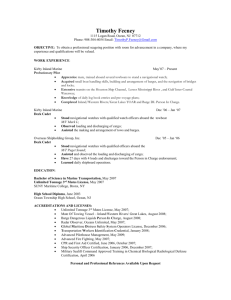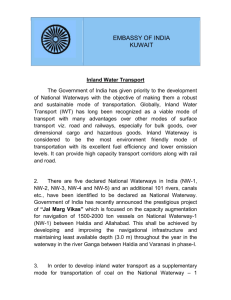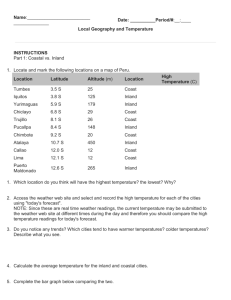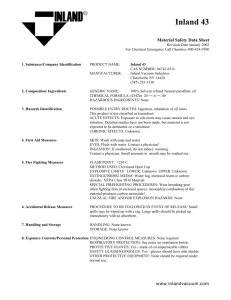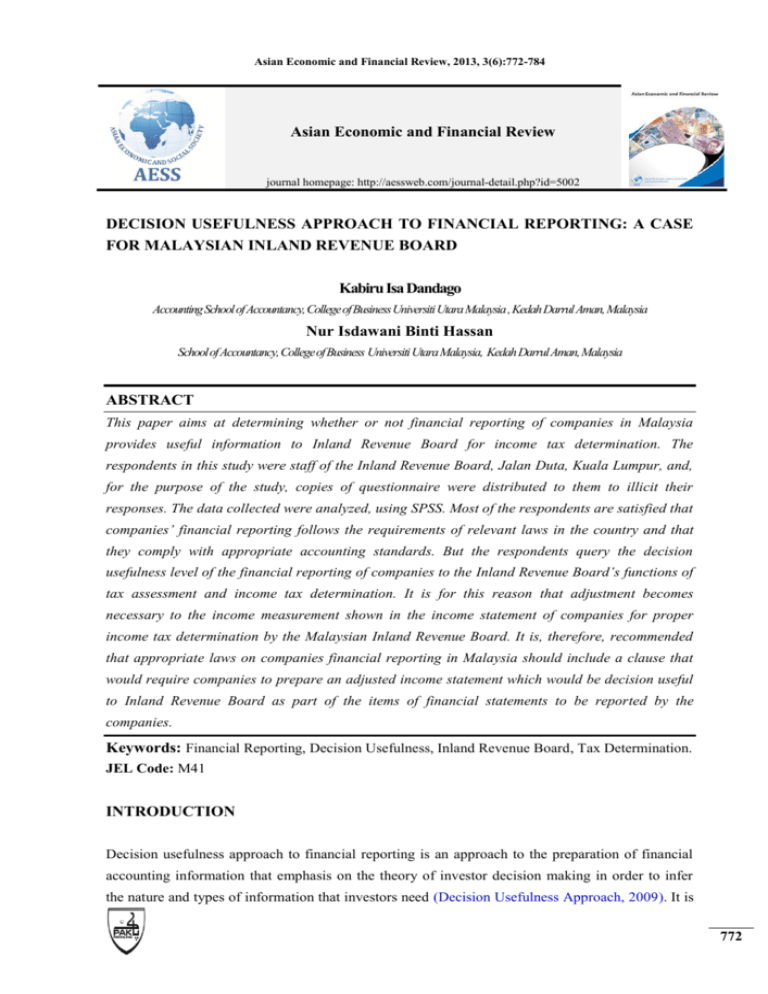
Asian Economic and Financial Review, 2013, 3(6):772-784
Asian Economic and Financial Review
journal homepage: http://aessweb.com/journal-detail.php?id=5002
DECISION USEFULNESS APPROACH TO FINANCIAL REPORTING: A CASE
FOR MALAYSIAN INLAND REVENUE BOARD
Kabiru Isa Dandago
Accounting School of Accountancy, College of Business Universiti Utara Malaysia , Kedah Darrul Aman, Malaysia
Nur Isdawani Binti Hassan
School of Accountancy, College of Business Universiti Utara Malaysia, Kedah Darrul Aman, Malaysia
ABSTRACT
This paper aims at determining whether or not financial reporting of companies in Malaysia
provides useful information to Inland Revenue Board for income tax determination. The
respondents in this study were staff of the Inland Revenue Board, Jalan Duta, Kuala Lumpur, and,
for the purpose of the study, copies of questionnaire were distributed to them to illicit their
responses. The data collected were analyzed, using SPSS. Most of the respondents are satisfied that
companies’ financial reporting follows the requirements of relevant laws in the country and that
they comply with appropriate accounting standards. But the respondents query the decision
usefulness level of the financial reporting of companies to the Inland Revenue Board’s functions of
tax assessment and income tax determination. It is for this reason that adjustment becomes
necessary to the income measurement shown in the income statement of companies for proper
income tax determination by the Malaysian Inland Revenue Board. It is, therefore, recommended
that appropriate laws on companies financial reporting in Malaysia should include a clause that
would require companies to prepare an adjusted income statement which would be decision useful
to Inland Revenue Board as part of the items of financial statements to be reported by the
companies.
Keywords: Financial Reporting, Decision Usefulness, Inland Revenue Board, Tax Determination.
JEL Code: M41
INTRODUCTION
Decision usefulness approach to financial reporting is an approach to the preparation of financial
accounting information that emphasis on the theory of investor decision making in order to infer
the nature and types of information that investors need (Decision Usefulness Approach, 2009). It is
772
Asian Economic and Financial Review, 2013, 3(6):772-784
an approach usually adopted to satisfy the information needs of the primary users of the financial
reports of the reporting entities: investors and creditors. Other stakeholders to a firm‟s financial and
non-financial activities are hardly considered in addressing their specific information needs through
adjustment of general purpose financial reports.
According to Wild (2008) and Fellingham (2005), accounting is viewed as the measurement
activity that provides financial reports in support of decision makers and their business decisions.
Financial reporting is the communication of financial information useful for making investment,
credit, and other business decisions (Chiappetta et al., 2009). Such communications are carried in
general purpose financial statements such as balance sheet, income statement, equity reports, cash
flow statement, and notes to the financial statements. Financial reporting is governed by statutory
and common law as well as institutional and ethical standards. Unfortunately, Financial reporting
sometimes falls short of both legal and ethical standards, which makes the reports useful to some of
the target users (like Inland Revenue Board) as they take informed decisions. Lamont (1992) states
that of all the powers of government, other than its authority to declare war, none bears so
incisively upon the welfare of citizens, both privately and in their economic enterprise, as does its
power to tax.
The effect of taxation is that subjects are forced to give up hard earned earnings or possessions
without receiving visible benefits in return (Coetzee, 1993). In every jurisdiction, Inland Revenue
Board is empowered to collect tax from individuals and companies. Inland Revenue Board is an
agent of government that provides services in assessing, administering, collecting and enforcing the
payment of income tax and other taxes that are under its jurisdiction Malaysian (Inland Revenue
Board, 2012). Adequate information is needed as the income tax payable is determined by the tax
authorities for fairness to be shown, and that is where decision useful financial statement to the
Inland Revenue Board becomes necessary. In the absence of useful guiding information on tax
assessment and collection taxation, could be unnecessarily heavy or too low, which could lead to
some uncertainty and crisis in the economic system of a country (Dickson and Nwaobia, 2012;
Ngerebo, 2013).
Although there are a number of individuals and companies who have been voluntarily reporting
their income and are paying their tax liabilities properly, there are a few individuals and companies
who have not been doing so. Taxpayers, especially companies, need to submit their audited
financial statements to Inland Revenue Board for the purpose of income tax determination.
The objective of this study is to determine whether or not financial reporting of companies in
Malaysia provides useful information to Inland Revenue Board for income tax determination. To
achieve this objective, the study makes effort to find answers to the following research questions:
773
Asian Economic and Financial Review, 2013, 3(6):772-784
1) Is companies‟ financial reporting in line with the disclosure requirements of Malaysian
Inland Revenue Board?
2) Is the financial reporting of Malaysian companies useful to Inland Revenue Board for the
purpose of income tax determination?
The outcome of this research allows room for a better understanding of the relevance of the
financial statements provided by Malaysian companies to the decision taken by the Inland Revenue
Board in determining the tax liabilities of reporting entities.
LITERATURE REVIEW
Theoretical Underpinning
When conditions are not ideal, there is no such thing as „perfect‟ or „true and fair‟ financial
statements. Instead, accountants try to prepare statements that are useful to users. To do this, the
accountant must identify who are the users and understand their decision problems and information
need. Examples of users are investors, government, creditors and others.
Investors need the
information to decide whether they should invest in a company or not, while government interested
in the allocation of resources and, therefore, the activities of entities. It also needs the companies
accounting information in the estimation of national income. Creditors are interested in companies‟
information to enable them determine whether or not amounts owing to them will be paid when
due. Single-person decision theory, which is based on the viewpoint of an individual who must
make a decision under conditions of uncertainty, is the underpinning theory to this study. The
theory sets out a procedure for allowing additional information to be obtained from reporting
entities to revise a decision-maker‟s subjective assessment of the probabilities of what might have
happened after a decision is made. The theory is promoted by scholars like Raiffa (1968), Demski
(1972), Sterling(1979), Ijiri (1983), Solomons (1989), Laffond (1989), Staubus (1999),
Cartney(2004), Henderson (2005), Godfrey et al.(2006) and Scott (2009).
Single-person decision usefulness theory takes the view that “if we can‟t prepare theoretically
correct financial statements, at least we can try to make financial statements more useful”. The
usefulness of financial statements should not be restricted to investors and creditors. Other
stakeholders to the affairs of reporting entities, like Inland Revenue Board, should also obtain
accounting information that is useful to their decision needs from the reporting entities. Financial
statements adopt a reasonable trade-off between relevance and reliability. Relevance and reliability
are both critical for the quality of the financial information, but both are related such that an
emphasis on one will hurt the other and vice versa. Hence, preparers of financial statements have to
trade-off between them to make sure that they are both reflected without having any of the two
exercising dominant influence on the direction of the financial statements. Accounting information
774
Asian Economic and Financial Review, 2013, 3(6):772-784
is relevant when it is provided in time, but at early stages of an entity‟s operations information is
uncertain and hence less reliable no matter how timely it is.
Conceptual Framework
Financial reporting is orientated to one of two ways: towards decision makers (the users who
require the information contained in financial statements for particular decisions) or towards the
decision models being used to make those decisions, for which that information constitutes the
input (Sterling, 1970). Users of financial reports might be able to make direct use of the
information contained therein to take various informed decision or they might have to employ the
services of some experts to guide them in appreciate the message contained therein and how to
utilize it in taking informed decisions. In any case, the beauty of financial report is its decision
usefulness and, so, it is ethical for a reporting entity to try and make it very useful to identified
users, even where some adjustments to the theoretical financial statements becomes necessary.
The purpose of financial reporting is to provide financial information about the reporting entity that
is useful to present and potential equity investors, lenders and other creditors in making decisions.
In their capacity as capital providers, decision usefulness requires relevance and reliability of
information (Barth et al., 2001). Seen from the accounting regulators‟ perspective, relevance is
concerned with the economic phenomena of the capital providers‟ decisions and it is the
application of the qualitative characteristics of relevance that will identify the economic
phenomena to be depicted in the financial reports. Reliability too is defined in terms of other
characteristics although of course it is also dependent on the decision being taken. What might be
reliable information for one purpose may be insufficiently reliable for another (Solomons, 1986).
This makes it important or necessary for reporting entities to ensure that appropriate adjustments
are made to general purpose financial statements with a view to making financial statements more
useful to every target user.
Williams (2009) states that accounting research for the past four decades has focused heavily on the
concept of decision-usefulness, which then also became the agreed-upon guide for judging the
effectiveness of accounting and financial reporting. This connection between i) the users of
financial statements, ii) the objective of decision-usefulness and iii) accounting standard setting
was forged fairly recently and was initially quite controversial (Young, 2006). The Malaysian
Inland Revenue Board is empowered to require a company or any person involved with that
company to produce the company's books of accounts and any other documentation for inspection,
tax assessment and income tax collection (Taxes Management Act, 1970). The Board deserves
useful information for accurate decision on the tax liability to be settled by the taxpayers (the
reporting entities).
775
Asian Economic and Financial Review, 2013, 3(6):772-784
Review of Empirical Studies
According to Wild (2008) and Fellingham (2005), accounting is considered as the measurement
activity that presents financial reports in support of decision makers and their business decisions.
The usefulness of accounting information is made up of many factors which, according to Ijiri and
Jaedicke (1966), Buys (2008) and Dzinkowski (2010), include the timeliness, reliability, relevancy
and materiality of the presented accounting data. Financial statements are to provide information
for decision making purposes and to show the results of stewardship of the management. Both
objectives cannot be achieved by using the same set of accounting standards (Gjesdal, 1981).
Generally Accepted accounting principles (GAAP) are the accounting rules used to prepare and
standardize the reporting of financial statements items, such as balance sheets, income statements
and cash flow statements, for publicly traded companies and many private companies (Paul, 2008).
Reporting entities have to comply with the provisions of appropriate laws and accounting standards
in preparing financial statements. At the same time they would want to ensure the usefulness of the
statements for facilitating effective decision making by all users of the information contained
therein.
The relationship between the powers and practices of the Inland Revenue Board in tax assessment
and collection in the context of the usefulness of the reporting entities‟ financial statements for that
purpose is largely ignored. Accounting has restricted itself to the technical computation and
recording of tax liabilities or to the technicalities of tax investigations (Helsby, 1986). The study of
the relationship between Malaysian Inland Revenue Board and accounting practice has become
more relevant since the Board‟s modification of its investigation techniques in 1976 (Coetzee,
1993). These investigation techniques include an in-depth examination of the „companies'
accounts‟ and an inquiry into the records and underlying information from which they are
constructed. The Board has therefore "moved away from being a technically oriented body to
primarily an investigative agency", resulting in an increasingly adversarial world of tax
investigations (Helsby, 1986).
STATEMENT OF METHODOLOGY
This section describes and explains the population and sampling frame as well as the instrument
used to obtain data. The data are used to answer research questions as outlined in section one of the
paper. Staff in the Inland Revenue Board, Jalan Duta, Kuala Lumpur, Malaysia are used as
respondents in this study. According to Sekaran and Bougie (2010), population refers to the entire
group of people, events or things of interest that the researcher wishes to investigate. It is the group
of people, events, or things of interest on which the researcher wants to make inference (based on
sample statistics). The population of this study consists of 30 staffs who are involved in the tax
assessment and collection work of the Inland Revenue Board, Jalan Duta, Kuala Lumpur. For the
776
Asian Economic and Financial Review, 2013, 3(6):772-784
purpose of the study, the researchers distributed copies of the questionnaire to all the 30 staffs,
thereby resorting to 100% sampling of the population.
The questionnaire was delivered with the cover letter to each of the target respondents at Inland
Revenue Board, Jalan Duta, Kuala Lumpur. Table 3.1 shows the process of data collection for this
study. Data were analyzed using descriptive statistics that include mean, standard deviation,
frequency, and percentage, with the use of SPSS. For section A, the researchers used frequency and
percentage method while for sections B and C; the data were analyzed using mean and standard
deviation.
RESULTS AND DISCUSSION
This section of the paper explains the findings of this research. All findings were based on
questionnaire that was administered on the respondents. The data were analyzed using the SPSS
(version 19.0). This section begins with the data collected through Section A of the questionnaire,
which exhibits the demographic information of the respondents in the Inland Revenue Board, Jalan
Duta, Kuala Lumpur. These include gender, age and race, length of service and education level.
Copies of the questionnaire were distributed to thirty employees of Inland Revenue Board, who are
involved in assessment and collection of companies‟ income tax. Respondents were given a week
to complete the questionnaire, so they had enough time to answer the questions. After one week, 20
completed copies of the questionnaire were collected.
Demographic Analysis
Table 4.1 shows the distribution of the respondents‟ gender. As shown in table 4.1, ten respondents
(50%) are male and another 10 (50%) are female. This shows that the respondents‟ gender is
balanced; suggesting that gender biasness could not influence the outcome of the study.
Table 4.2 shows the respondents‟ age. From the table, it is clear that ten respondents (50%) are in
the age bracket of 21 to 30 years old; 9 of respondents (45%) are in the age bracket of 31 years old
and above and only one respondent (5%) belongs to the age bracket of less than 21 years old. This
implies that majority of the respondents are in the age bracket of 21-30 years, suggesting that most
of the income tax assessors and collectors in the Malaysian Inland Revenue Board are youth who
need a lot of on-the-job and off-the-job training and re-training for them to be effective and
efficient as tax administrators.
Table 4.3 indicates that all the 20 respondents who returned the completed questionnaire are
Malays. This suggests that in the income tax assessment and collection unit/department of the
Malaysian Inland Revenue Board a great majority, if not all, of the staff a Malay.
777
Asian Economic and Financial Review, 2013, 3(6):772-784
Table 4.4 exhibits the study‟s finding about the length of service of respondents. It shows that 90
percent of the respondents have been working in the Inland Revenue Board for less than 4 years
and only 10 percent of them have been working in the Inland Revenue Board for between 4 to 6
years. This implies that most of the respondents are inexperienced in income tax assessment and
collection, which further justifies the need for training and, of course, effective supervision and
mentoring.
Table 4.5 reports the highest academic qualification of the respondents. The table shows that
majority of the respondents possess bachelor‟s degree and above with 85 percent response rate and
only 15 percent of the respondents are Diploma holders. This implies that the Board‟s recruitment
requirement emphasizes greatly on possession of a university degree. However, it is not confirmed
if the Bachelor degrees or above must be in the areas of Taxation, Accounting, Finance, Economics
and other relevant areas.
Test of Research Questions
Research Question 1
Is companies’ financial reporting in line with the disclosure requirements of
Malaysian Inland Revenue Board?
In order to test this research question, seven questions were asked. A five point Likert scale was
used to elicit responses. These include: 1= strongly disagree, 2= disagree, 3= uncertain,4= agree,
and 5= strongly agree. Table 4.6 indicates results obtained using the descriptive statistics of mean
and standard deviation.
Findings show that the overall mean for this result is a mean score of 3.77 (SD=.097) as shown in
table 4.6. The high mean score of 3.77 indicates that most of the respondents agreed and are
satisfied that Malaysian companies‟ financial reporting follows the disclosure requirements of
relevant laws and relevant accounting standards. The Board, however, has to adjust the companies‟
profit for tax purpose in line with the provisions of the country‟s income tax law. The Board rejects
financial reports that are not in strict compliance with the provision of appropriate Malaysian laws
and appropriate accounting standards in use in the country.
Where the financial statements of reporting entities are not in compliance with the disclosure
requirements of relevant laws and accounting standards in Malaysia, the Inland Revenue Board
reject the financial statements (especially the income statement) and assess the reporting entities
income for tax purpose using Best of Judgment Assessment (BOJA). This is bound to result to
higher tax liability than the liability that could be arrived at using the audited income statement as a
basis of the tax assessment. This shows that financial statements (especially income statement)
must be tailored to be decision useful to the tax authority.
778
Asian Economic and Financial Review, 2013, 3(6):772-784
Research question 2
Is the financial reporting of Malaysian companies useful to Inland Revenue Board for
the purpose of income tax determination?
Research question two focuses on whether or not financial statements provided by Malaysian
companies are useful to Inland Revenue Board for tax liability determination. Three questions were
asked with five point Likert scale used to elicit responses. These include: 1= strongly disagree, 2=
disagree, 3= uncertain, 4= agree, and 5= strongly agree. Table 4.7 indicates results obtained using
the descriptive statistics of mean and standard deviation. Finding: Based on the results in table 4.7,
it can be concluded that majority of the respondents felt uncertain at mean score of 3.28 (SD=.248)
as to whether or not financial statements of Malaysian companies are really useful to Inland
Revenue Board for determining the income tax liabilities of the reporting entities. But where the
statements are acceptable to the tax authority, the statements would be useful since they serve as
basis of tax liability computation, after adjusting the income for tax purpose. It is for this reason
that the Board must have to critically adjust profit as per the income statement provided for the
purpose of arriving at chargeable profit on which tax rate is applied to determine the tax liability.
The adjustment is to be made as per the provisions of income tax law.
CONCLUSIONS AND RECOMMENDATIONS
Conclusions
Based on the review of related literature, results obtained and discussions thereon, the following are
the major conclusions of the study:
1.
Decision usefulness approach to financial reporting practices of companies is normally
skewed towards serving the interest of investors (existing and prospective) and, to some
extent, creditors. No specific approach to financial reporting is found, from the literature,
to be in practice for the provision of decision useful information to other stakeholders, like
the Inland Revenue Board, apart from the general purpose financial report.
2.
The age bracket, length of working experience, and educational qualifications of the
participants in this study suggest that the Malaysian Inland Revenue Board is „youth
dominant‟. This suggests that reasonable investment is required for on-the-job and off-thejob training and retraining of the Inland Revenue staff, for career development, efficiency
and effectiveness in tax administration to be assured.
3.
Even though the Board has to adjust profit as per the income statement of the reporting
entities for tax purpose, the Malaysian Board of Inland Revenue is satisfied that the
audited financial statements accompanying tax returns of companies are prepared in
compliance with the provisions of appropriate laws and relevant accounting standards. But
779
Asian Economic and Financial Review, 2013, 3(6):772-784
the income statement, in particular, must be tailored to be decision useful to the tax
authority before income tax liability is determined.
Recommendations
Based on the conclusions of the study, the following recommendations are hereby made:
(i) Appropriate laws in Malaysia (like BAFIA), which made some provisions for corporate
financial reporting, should carry a clause that would require reporting entities to
prepare an adjusted income statement which would be decision useful to Inland
Revenue Board as part of the items of financial statements to be reported by the
taxpaying companies.
(ii) While investment in training, mentoring and supervision is good for career development
of staff of the Board, it is important to ensure that staffs to be recruited to the tax
assessment and collection unit/department have strong background in taxation or
accounting, especially good knowledge of financial statements preparation,
interpretation and adjustment for taxation and other purposes.
REFERENCES
Barth, M.E., W.H. Beaver and W.R. Landsman, 2001. The relevance of the value
relevance literature for financial accounting standard setting: Another view, .
Journal of Accounting and Economics, 31: 77-104.
Buys, P.W., 2008. In pursuit of a foundational accountancy philosophy. Koers, 73(3):
489-509.
Chiappetta, B., K. Shaw and J. Wild, 2009. Principles of financial accounting 19th Edn.,
New York: McGraw-Hill Irwin.
Coetzee, H., 1993. Reluctance to pay tax: What do people expect from a tax system in the
new south africa? . Accountancy SA, .
Cartney, S.M., 2004. The use of usefulness: An examination of the user needs approach to
the financial reporting conceptual framework The Journal of Applied Accounting
Research 7(2): 15-21.
Decision Usefulness Approach, 2009. . education.org.
Demski, J., 1972. Information analysis. Reading MA: Addison-Wesley.
Dickson, T.U. and A.N. Nwaobia, 2012. Impact of heavy taxation on israel during
solomonic era: Implication for nigerian tax system. Asian Economics and
Financial Review, 2(3): 337-346.
Dzinkowski, R., 2010. More financial transparency please, . Strategic Finance, January:
44-47.
780
Asian Economic and Financial Review, 2013, 3(6):772-784
Fellingham, G.A., 2005. Information economics and management accounting: A brief
personal perspective Journal of Management Accounting Research, 17: 145-152.
Gjesdal, A., 1981. Accounting for stewardship. Journal of Accounting Research, 19: 208231.
Godfrey, J., A. Hodgson, S. Holme and A. Tarca, 2006. Accounting theory 6th Edn.,
Australia (GHHT): John Wiley & Sons.
Henderson, B.C.a.K., S.E. , 2005. An examination of the role of ethics in tax compliance
decisions. The Journal of the American Taxation Association, 8(3): 39-72.
Helsby, J., 1986. Trouble with the taxman? . London: Deloittes, Haskins and Sells.
Ijiri, Y. and R.K. Jaedicke, 1966. Reliability and objectivity of accounting measurements.
The Accounting Review, 41(3): 474-483.
Ijiri, Y., 1983. On the accountability-based conceptual framework of accounting. Journal
of Accounting and Public Policy, 2(2): 75-81.
Inland Revenue Board, 2012. Inland Revenue board.
Laffond, J.J., 1989. The economics of uncertainty and information. Cambridge: MIT
Press.
Lamont, M., 1992. The economics of a land tax. Pretoria: University of Pretoria Centre for
Human Right.
Ngerebo, T.A., 2013. Unraveling the uncertainty of the niger delta crisis through taxation
Asian Economics and Financial Review, 3(2): 186-195.
Paul, S., 2008. Generally accepted accounting principles (gaap). What does it mean?
Legal Zoom.
Raiffa, H., 1968. Decision analysis: Introductory lecture on choices under uncertainty.
Reading MA: Addison-Wisley.
Scott, W.R., 2009. Financial accounting theory. 5th Edn., Toronto: Toronto (SWR):
Pearson Prentice
Hall International Inc.
Sekaran, U. and R. Bougie, 2010. Research methods for business 5th Edn.: John Wiley &
Son Ltd.
Sterling, R.R., 1970. On theory construction and verification. Accounting Review, 45(3):
444-457.
Solomons, D., 1989. Guidelines for financial reporting standards. London: Institute of
Chartered Accountants in England and Wales.
Staubus, G.J., 1999. The decision-usefulness theory of accounting: A limited history. New
York and London: Garland Publishing, Inc.
Sterling, R.R., 1979. Towards a science of accounting. Houston, Texas: Scholars Book
Company.
Taxes Management Act, T., 1970. London: Her majesty's stationery office.
781
Asian Economic and Financial Review, 2013, 3(6):772-784
Wild, J.J., 2008. Financial accounting: Information for decisions. Boston: McGraw-Hill
Irwin.
Williams, P., 2009. Rethinking decision usefulness. In: A paper read at the 9th
Interdisciplinary Perspectives on Accounting Conference held in Innsbruck.
Austria.
Young, J.J., 2006. Making up users Accounting Organizations and Society, 31 (6): 579600.
APPENDICES
Table-3.1. Data collection procedures
Duration
Week 1
Activities
Researchers distributed thirty copies of the questionnaire together
with the cover letter.
Respondents were given one week to complete the questionnaire.
Only 40 percent of return rate was expected.
Followed up through telephone calls due to time constraint.
Achieved more than the targeted response as 20 respondents returned
completed copies of the questionnaire.
Week 2
Source: Researchers‟ Design, 2012
The questionnaire used has been designed with the three sections as shown in table 3.2 below:
Table-3.2. Survey instrumentalization
Section A: Demography
Section
B:
Statements
Financial
Decision
Section
Usefulness
C:
The questionnaire asked for information related to the
participants‟: (a) Gender; ( b) Age; (c) Race; (d)
Length of Service; and (e) Education level.
The questionnaire asked for data related to financial
reporting provided by companies to the Inland
Revenue Board.
The questionnaire asked for information related to the
decision usefulness approach of financial reporting to
Inland Revenue Board.
For section B and C, the questionnaire utilizes a Likerttype scale with 5 response alternatives : „Strongly
disagree‟(weighted 1), „Disagree‟ ( weighted 2),
„Uncertain‟ ( weighted 3), „Agree‟ (weighted 4), and
„Strongly Agree‟(weighted 5)
Source: Researchers‟ Design, 2012.
Valid
male
female
Total
Table-4.1. Gender of respondents (n=20)
Frequency
Percent
Valid Percent
10
50.0
50.0
10
50.0
50.0
20
100.0
100.0
Cumulative Percent
50.0
100.0
Source : Field Survey, 2012
782
Asian Economic and Financial Review, 2013, 3(6):772-784
Table-4.2. Age of respondents (n=20)
Valid
less than 21 years
21-30 years
31 and above
Total
Source : Field Survey, 2012
Valid
malay
Frequency
1
10
9
20
Percent
5.0
50.0
45.0
100.0
Valid Percent
5.0
50.0
45.0
100.0
Table-4.3. Race of respondents (n=20)
Frequency
Percent
Valid Percent
20
100.0
100.0
Cumulative
Percent
5.0
55.0
100.0
Cumulative Percent
100.0
Source : Field Survey, 2012
Table-4.4. Length of services of respondents (n=20)
Valid
4-6 years
less than 4 years
Total
Frequency
2
18
20
Percent
10.0
90.0
100.0
Valid Percent
10.0
90.0
100.0
Cumulative
Percent
10.0
100.0
Source : Field Survey, 2012
Table-4.5. Educational level of respondents (n=20)
Valid
Frequency
Diploma
3
Bachelors Degree and above 17
Total
20
Percent
15.0
85.0
100.0
Cumulative
Valid Percent Percent
15.0
15.0
85.0
100.0
100.0
Source : Field Survey, 2012
Table-4.6. Descriptive statistics of overall Financial reporting in line with the disclosure
requirements of Malaysian Inland Revenue Board
MEANFINANCIAL
Valid N (listwise)
N
20
20
Mean
3.7714
Std. Deviation
.09722
Source : Researchers‟ Design, 2012
Table-4.7. Usefulness of Financial reporting of Malaysian Companies to Inland Revenue Board
for Income Tax Determination.(n=20)
Descriptive Statistics
MEANRB
Valid N (listwise)
N
20
20
Mean
3.2833
Std. Deviation
.24839
Source : Researchers‟ Design, 2012
783
Asian Economic and Financial Review, 2013, 3(6):772-784
Acknowledgements
The authors would want to thank the Head, Department of Accounting and Taxation, Universiti
Utara Malaysia, Assoc. Professor Zuaini Bt Ishak, and the Dean, School of Accountancy, College
of Business, Universiti Utara Malaysia, Prof. Dr. Kamil MD Idris for their encouraging comments.
We also acknowledge the inputs made by the discussants and other contributors during the
2012/2013 MSc (International Accounting) First Semester class seminar for BKAF5043 at the
Universiti Utara Malaysia.
784

